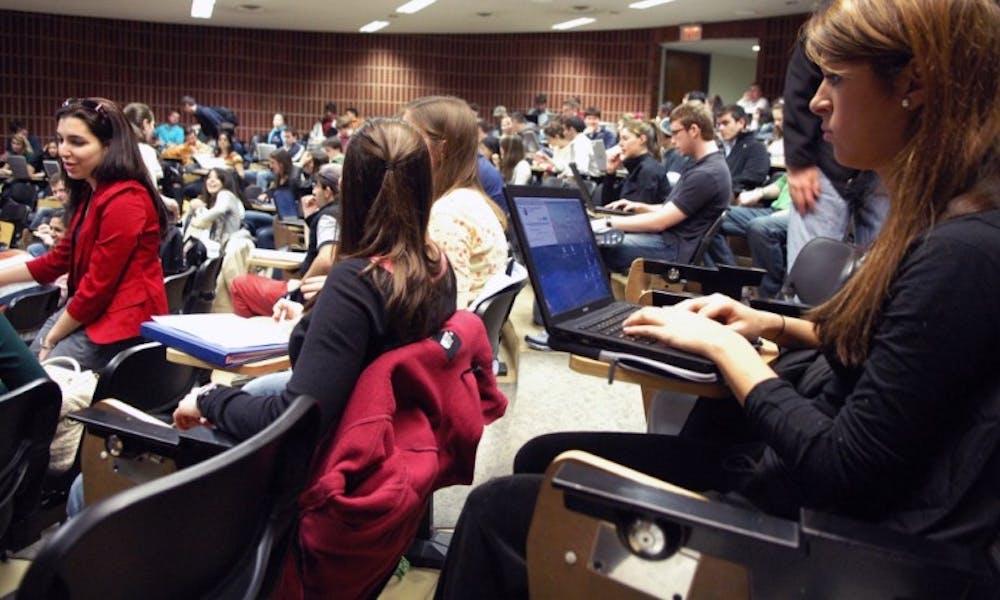Penn’s take on active learning courses has had a rocky start, but calmer waters may lay ahead as Structured, Active, In-Class Learning, or SAIL, courses expand into the humanities.
The SAIL method emphasizes student engagement and active participation during time that is typically allotted to instructor lecturing.
“One thing we ask is, ‘Can we transform what happens in the lecture space?’” said Bruce Lenthall, executive director of the Center for Teaching and Learning, who has been spearheading the initiative.
In the past, many students have expressed frustration over SAIL courses. The Student Committee for Undergraduate Education included several problems it found with the way SAIL was being implemented in its 2015 White Paper, a comprehensive review of undergraduate education released every five years.
The review found unhelpful ways that students were giving feedback to instructors, inadequate training for faculty using SAIL methods and ineffective use of the flipped classroom, a common application of SAIL in which students watch lectures at home and use class time for group work and other activities.
While problem sets and videotaped lectures remain part of many SAIL courses, especially in math and science disciplines, adapting SAIL to humanities courses has opened the door to new variations of the model.
“[SAIL] takes a lot of different forms depending on the type of class you’re applying it to,” College senior and SCUE chair Laura Sorice said. “We can definitely see how students in all different disciplines would benefit from this type of engagement.”
Sorice gave the example of “Classical American Constitutional Law” taught by Rogers Smith, a political science course that is also a successful SAIL class. In Smith’s course, students watch recordings of his lectures outside of class, in addition to completing assigned readings. During actual lecture time, Smith asks discussion questions to prompt debates among students.
“The opportunity to engage in a debate on constitutional law with one of the best professors in that field — that’s a really good example of the way that SAIL can work for humanities classes,” Sorice explained.
College junior and current participant in the course Taylor Becker agreed, “You get to hear a lot of different perspectives. Students probably do half the talking in the class.”
Smith’s class is not the only humanities course using SAIL. Several professors in departments such as Political Science, History and the health & societies major have added SAIL principles to their curricula.
So far, Lenthall has been pleased by SAIL’s growing popularity.
“More faculty are getting more excited to think about it,” he said.
CTL has taken steps to ease professors’ transitions to using SAIL to address early apprehension. It provides faculty interested in SAIL with numerous resources, including individualized consulting with CTL, facilitated meetings with other faculty and access to its research into student learning outcomes in both SAIL and non-SAIL courses.
“It has been a gradual change,” Lenthall said. “We don’t expect this to transform overnight. Reinventing a class is hard work. It takes a lot of investment from faculty who decide to do this.”
Lenthall added that elements of SAIL have begun to resonate with students.
“If you ask, ‘How did you like working on problems in groups and learning from your peers?’ [students] say, ‘I loved that,’” he said.
As SAIL courses grow in number, Penn has stepped up to accommodate them. Department chairs, faculty and administrators ranging from the vice provost for education, the deans of the undergraduate schools and even those responsible for maintaining Penn’s classrooms have worked to help SAIL’s growth.
“Each year we bring on more classrooms that are set up for this,” Lenthall said. “These are rooms that really lend themselves to this kind of teaching.”
This fall alone, Penn added two SAIL-friendly classrooms, including one in the David Rittenhouse Laboratory.
Ultimately, Lenthall’s goal is to keep asking, “Have we helped our students learn as much as possible?”



